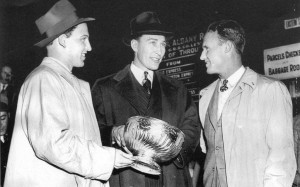In Dit: Dit Clapper and The Rise Of The Boston Bruins, authors Stewart Richardson and Richard LeBlanc illustrate the life and career of one of the great players in hockey’s early history. I had a chance to talk with lead-author Richardson just a day after reading this very interesting biography earlier this month.
Aubrey Victor ‘Dit’ Clapper, a native of Hastings, Ontario, earned considerable acclaim during his long time in the NHL. For twenty years, he was a pivotal contributor for the Boston Bruins. He remains the only Bruin to win three Stanley Cups with the franchise (in 1928, 1939 and 1941) and his retired #5 flies high above Boston’s TD Garden ice.
Clapper was the first player to play in the League for twenty years or earn an All-Star nod at both defenseman and forward positions. He is one of just seven players to have the mandatory waiting period for Hall of Fame enshrinement waived, entering the prestigious institution in 1947.
Richardson – a former resident of Hastings – “collaborated years ago” with LeBlanc, a fellow writer and “old friend”. The two spent several years researching Clapper.
“I come from the village of Hastings (where Dit grew up),” Richardson told me. “…I had the support of the Hastings Historical Society… We both joined the Society for International Hockey Research… and originally thought [the book] was going to be a small article for SIHR members… but the more we got into it, the more we realized: There’s a huge oversight here…”
Dit works on several levels: Foremost, as a biography; furthermore, as a history of the early era – the ‘Pre-Spoked’ Era – of the Boston Bruins; finally, as a history of the League and the game of hockey through its tumultuous and constantly-evolving era during the second quarter of the twentieth century.
On this level alone is Dit worth the price, for the authors weave the story of the NHL and its founding fathers throughout the tale of the Bruins’ skater. Major segments are given to Art Ross and others and the game’s remarkable progression during Clapper’s career.
“We wanted the readers to come away not only with information on [Dit Clapper] but also a general history of the NHL in the early years,” said Richardson.
The book excels in delivering frequent and detailed passages relating to specific, central events in Clapper’s life: His career-threatening calf injury in January 1942, his remarkable altercation with then-referee (and eventual NHL president) Clarence Campbell in March of 1937, and many more.
While the rendering is subtle at first, the authors ably evince Clapper’s personality via these vignettes. The soft-spoken Bruin is flattered in this portrait: His work-ethic, determination, skill, and loyalty are inescapably elucidated.
The writers go into great specifics to portray Clapper’s profound sense of on-ice morality. During a time when the B’s had the notoriously ‘dirty’ Eddie Shore patrolling the blue line, Clapper’s sensibilities are distinguished as far more righteous – if no less evident was: “… the force he could muster when he thought he or his teammates had been severely wronged.”
That force, evidenced clearly in Dit, made him equally feared and revered. But it was through the authors’ demonstrations of his driven but friendly nature that I found myself truly enjoying learning more about this somewhat taciturn but patently congenial man. “He had a quiet but unrelenting confidence to him, and had such a good effect on the young players on the team…” Richardson stated.
This reader finished wondering if Dit Clapper’s deep-seeded need for success may have wounded his post-playing life. Later chapters deal with his ultimately unsuccessful forays into full-time coaching, business, and politics. The picture painted reveals a man whose post-playing-career aspirations were – to an extent – unrealized. Clapper’s hardly a tragic figure, but there exists some modest melancholy towards the book’s end.
The authors should also be commended for their attention to detail in prefacing Clapper’s life. They set up his early years with significant details about his family history, particularly regarding his athletically-gifted father, Willy.

At some points, it reads too overly-straightforward and the authors’ recapping of game and seasonal storylines grows a tad repetitive. Still, in that way, the reader is transported to the bygone era – Dit Clapper’s era – predating the video highlight, when newspaper-journalism was many folks only window into the daily happenings of sport. At times, the rhythm is a bit numbing and readers are left waiting for the best anecdotes which breathe life into the middle chapters.
The reader may finish the biography in one four-to-five hour sitting. I found it desirable to take-in this way, leaving with a distinct impression of this pillar of the NHL’s (and Boston Bruins’) history.
Dit is a well-researched and fully-realized tale of one of the greats to play the game. Despite several minor shortcomings, Dit remains a worthy addition to any Bruins or hockey-biography collection.